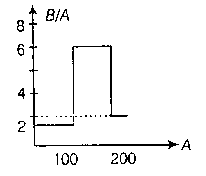A simple pendulum is setup in a trolly which moves to the right with an acceleration a on a horizontal plane. Then, the thread of the pendulum in the mean position makes an angle with the vertical
In the following diagrams, a particle with small charge – q is free to move up or down, but not sideways near a larger fixed charge Q. The small charge is in equilibrium because in the positions shown, the electrical upward force is equal to the weight of the particle. Which statement is true?
1. In figure a, -q is in stable equilibrium.
2. In figure a, -q is in neutral equilibrium.
3. In figure b, -q is in stable equilibrium.
4. Neither in fig(a) nor in fig(b) , q is in stable equilibrium.
\(1. \frac{1}{24} m A\\ 2. \frac{1}{12} m A\\ 3. \frac{1}{6} m A\\ 4. \frac{1}{3} m A\)
Assume that the nuclear binding energy per nuclear (B/A) versus mass number (A) is as shown in the figure. Use this plot to choose the correct choice(s) given below:
1. Fusion of two nuclei with mass number lying in the range of 51<A<100 will release energy
2. Fusion of a nucleus lying in the mass range of 200<A<260 will release energy when broken into two equal fragments
3. Both A and B
4. None of these
Another capacitor of capacitance 2C is connected to another battery and is charged to potential difference 2V. The charging batteries are now disconnected and the capacitors are connected in parallel to each other in such a way that the positive terminal of one is connected to the negative terminal of one is connected to the negative terminal of the other. The final energy of the configuration is





